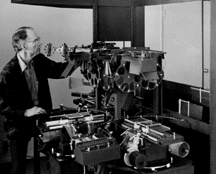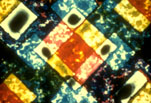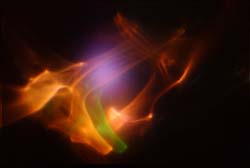 Charles
Dockum with his MobilColor 'color organ', (c) Greta Dockum
Charles
Dockum with his MobilColor 'color organ', (c) Greta Dockum
Moritz, William. Musique de la Couleur - Cinéma Intégral (Color Music - Integral Cinema). in Poétique de la Couleur. Paris: Musée du Louvre, 1995
Integral Cinema, as Germaine Dulac called it -- and none of the other terms for this genre ("Avant-Garde Film", "Experimental Film", "Art Film", "Visionary Film", "Underground Film", "Film as Film") seems better -- falls into two general categories: those using conventional cinematography to record and represent live people and situations (often imaginatively edited in an anti-realistic way), and those "abstract" films which use animation, direct handling of the film-strip, distorting lenses, superimposition, focus and other devices to create imagery that does not represent external realities but rather posits a new, special world of its own experience.
The representational film entertains a subtle relationship with color. The black-and-white image of reality, known from printed illustrations and photos, is universally recognized as an acceptable virtual representation of credible events. Most newsreels and feature films were shot in black-and-white. Sometimes individual details in shots might be hand tinted (using stencils), as for example in the fantastic films of Méliès, or the climactic communist flag in Battleship Potemkin which, due to orthochromatic black-and-white film, was shot with a white flag that could be tinted red on each projection copy. Many features were tinted in a kind of conventional coding: amber for indoor scenes in artificial light, blue for outside nighttime, red for fires, pink for ladies' boudoirs and love scenes, etc. Even so eccentric a film as The Cabinet of Dr. Caligari was originally tinted in exactly this code!
When experimental films began to be made in the early 1920s, often privately on a small budget, color did not have to be an extra concern. Dulac's Smiling Mme. Beudet might have used the conventional tints -- amber for the office scenes, blue for Mme. Beudet's nocturnal reveries, etc. -- but Dulac did not need color as an expressive device, since she has brilliantly visualized the conflicts in her scenes through anamorphic distortion, selective lighting and framing, changes of speed and focus, and other optical/cinematic devices independent of color. Similarly, René Clair's Entr'acte needs no color -- indeed, color might be distracting in the violence of its rollercoaster-ride montage, just as color would have confused (or "overloaded") Alexander Laszlo's 1927 visualization of Honneger's Pacific 231 with two side-by-side images pushing the viewer into a 120kph vortex. Lore Leudesdorff, however, told me that Walter Ruttmann had tinted his prints of the 1931 sound film In the Night a pale blue to enhance the nocturnal mood.
With the easy availability of color film stocks after World War II, experimental filmmakers could count on incorporating color nuances and effects among their visual vocabulary. Under the spell of the dazzling controlled Technicolor of Hollywood features, a triumvirate of young California filmmakers, Curtis Harrington (Renascence, 1944, etc.), Gregory Markopoulos (Psyche, 1947, etc.) and Kenneth Anger (Puce Moment, 1948, etc.), designed symbolic and sensual color elements into their "psychodramas". While Harrington turned gradually to feature films, Anger carried his color effects to extravagant heights in further integral films, tinting his 1953 Eaux d'artifice blue with hand-tinted highlights, and in his 1954 Inauguration of the Pleasure Dome choreographing layers of color effects incorporating colored sets and costumes, color lighting within scenes, and superimposed layering of colored elements. With great simplicity, Mike Kuchar in his 1966 Secret of Wendel Samson purposely used the amateur Kodachrome stock, with its brilliant cherry reds, to manipulate a sensitive color-code into a tale of a homosexual painter trying to avoid having to hide his identity -- and managed to make every homemade scene seem painterly.
Although Markopoulos made some further narrative films, he developed more toward a lyrical abstraction (Ming Green 1966, Gammelion 1968) in which formal values, including color, become the protagonists. Similarly Bruce Baillie's personal narratives stand side-by-side with exquisite colorist abstractions like the 1966 Castro Street, and Stan Brakhage's many personal narratives (filled with gestural abstraction) also yield to pure colorist films (Riddle of Lumen 1972, Text of Light 1974) culminating in the painted-on-film Dante Quartet (1983).
 Charles
Dockum with his MobilColor 'color organ', (c) Greta Dockum
Charles
Dockum with his MobilColor 'color organ', (c) Greta Dockum
In the area of abstract film, color assumes a greater, almost necessary role. A long tradition of "Color Music" theory and practice has posited that there should be a visual music comparably fluid and nuanced as auditory music. In the pre-cinema era, many artists created instruments which attempted to project some visual equivalent of music, including ca. 1750 Father Castel's Ocular Harpsichord which linked each key on the musical instrument with a flash of a certain colored light that Castel believed to be an exact equivalent of each musical tone. The 1893 electric Colour Organ of British painter A. Wallace Rimington mixed primary colors into more nuanced hues that could be projected on gently-moving gauzy curtains to obtain polymorphous color flows more appropriate to Romantic music -- and the Russian synaesthetic composer Alexander Scriabin, inspired by the possibilities of Rimington's Colour Organ, wrote a scenario of changing colors into the score of his 1910 Prometheus symphony. This color-organ tradition (which continued in the 1920s, 1930s and 1940s with artists such as Mary Hallock Greenewalt, Baron Anatol Vietinghoff-Scheel, Thomas Wilfred, and Charles Dockum) bore a direct influence on, a challenge to, abstract filmmakers -- for the cinema, with its standardized methods of production, reproduction and exhibition, seemed the ideal vehicle for Color Music.
Already before World War I, several artists tried to use film to produce abstract imagery. In 1911, the German psychologist Hans Stoltenberg, as part of his researches for a book Pure Color Art in Time and Space, and its Relationship to Music (published 1920), drew color abstract images on blank movie film. He remained a part of the German color-music scene, attending all four of the Color-Music Congresses in Hamburg (1927, 1930, 1933, 1936) and reprinting an expanded edition of his Pure Color Art in 1937 to spite the Nazi censorship ban on abstract art. The Corradini brothers, Arnaldo Ginna and Bruno Corra, began their Futurist art careers with attempts to build a color-organ followed by the production of nine abstract films painted directly on film stock in 1911 and 1912, the first four pure experiments, and the next five more extended artworks which exploited color durations and contrasts. Unfortunately none of these films survives. At the same time, in Paris, the painter Leopold Survage prepared several hundred color drawings as a "scenario" (or storyboard) for an abstract film, which he hoped the Gaumont studios would photograph on their new three-color Chronochrome/Gaumontcolor film, but the war interrupted this project, and many of the drawings were lost.
The first surviving abstract film, Walther Ruttmann's Light-Play Opus Nr. 1, was shot in 1919 and 1920, had a musical score composed for it, and premiered in April 1921. It makes brilliant use of color. Ruttmann had been a painter and his last abstract canvases were characterized by many delicate nuances of painterly brushstrokes and fine gradations of unmixed colors. In moving to film, Ruttmann tried to capture some of the same variety and dynamics by using three coloring techniques: tinting, toning and hand-tinting, that is, coloring the emulsion so dark areas have a hue, dying the film strip so the light areas have another color, and adding touches of other colors to specific shapes by painting directly on each film frame. This meant that each individual scene had to be printed separately (from black-and-white negative pieces), and each projection print of the film had to be assembled from a hundred fragments. The surviving copy of Opus 1 was somewhat incomplete, but one can reconstruct the film quite accurately because Ruttmann drew color pictures in the musical score (with precise indications of repeats and changes of color) so that the musicians could synchronize exactly. Ruttmann limited the imagery to a confrontation between hard-edged geometric shapes and softer pliant forms, and allowed the colors not only to characterize certain figures, but also to establish mood, as in the long blue "nocturne" of the second movement. When Ruttmann followed this with subsequent abstract Opus films, he avoided the complex color effects of his first film. He gave general orange and green tints to scenes in Opus 2 and Opus 3, but the all hard-edged, optically-vibrating Opus 4 remained black-and-white for maximum contrast.
Fischinger, from
1933 GasparColor tests with Staffs, (c) Elfriede Fischinger Trust
Oskar Fischinger met Walter Ruttmann at the premiere of Opus 1, and decided to devote himself to abstract filmmaking as well. When Fischinger fled Germany in 1936, many of his original prints and negatives were lost, but we know from surviving test strips that one of his earliest (1921-22) experiments, Currents (swirling colored liquids), was tinted in at least four colors: yellow, blue, green and pink. By 1924, the Hungarian composer Alexander Laszlo had developed what he called Color-Light-Music, which included a color-organ projection system, the Sonchromatoscope, which controlled several slide projectors and stage spotlights with changing color filters and fading capabilities. During a first concert tour in 1925, Laszlo used primarily painted slides, but met some criticism that the visuals seemed more banal and simplistic than the accompanying music. He engaged Oskar Fischinger to prepare some animated, moving abstractions to add into his Color-Light-Music performances. Fischinger designed a spectacular triptych, three side-by-side projectors, all elements tinted, and, as a climax, two additional film projectors overlapped the other three, with similar imagery, adding more complex layers of color. Laszlo's reviews changed to praise for the elaborate visuals which now seemed more interesting than Laszlo's Chopinesque music. Oskar also did not receive proper credit in programs or reviews, so he broke off the collaboration with Laszlo and began making his own abstract multiple-projector shows in Munich. One of these survives, R-1, A Form-Play, which contains elaborately edited mirror-image vertical patterns on the side panels and an equally intricate center montage of geometric shapes, cosmic symbols, organic wax and liquid oozes, and some drawn animation linking imagery. Most scenes are tinted in various colors. From the climactic moment, when the two extra projectors switched on, Fischinger took the original tinted strips and combined them onto Gasparcolor filmstock in 1933, when he was making the first tests with the new three-color-separation process. The brilliant colors are probably more vivid than the five overlapping projections of 1926/7, and indeed probably offer alternate color values because of the difference between additive overlapping of multiple projection on the same screen and the subtractive overlapping of three layered emulsions on the Gasparcolor film. In any case, Fischinger's extravagant, complex R-1 remains an astonishing manifestation of integral cinema and Color Music.
At the same time the Laszlo/Fischinger Color-Light Music played on tour throughout Europe, took place the historic Absolute Film Show, Sunday May 3, 1925, at the Ufa Cinema on Kurfürstendamm in Berlin. The program contained Walter Ruttmann's Opus 2, Opus 3, and Opus 4; Dudley Murphy's (with Man Ray and Fernand Léger) Ballet Mécanique, René Clair's Entr'acte, the first screening of Viking Eggeling's black-and-white abstraction Diagonal Symphony, and a one-minute black-and-white film test by Hans Richter, Film is Rhythm. Ludwig Hirschfeld-Mack from the Bauhaus gave a live performance of Three Part Color Sonatina for his "Reflectorial Color-Play", a large color-organ instrument that required several people to play it, moving around (according to a strict composed score) various boards with shapes cut in them that could catch different colored light and combine to modify each other's shapes and shadows as they moved. That a color-organ performance shared the "Absolute Film" program shows again how closely linked the world of Color Music and Integral Cinema was.
Oskar Fischinger made his greatest popular success with a series of some 16 black-and-white Studies, made in Berlin 1930-1932, all but one tightly synchronized to music. The first few were shown in cinemas as advertising for the recording, with a title at the end "You Have Heard Electrola disc No._____ ; Buy it at your local record shop", so they prefigure the ubiquitous MTV video clips. After Study No. 6, the question of music rights became more complex, but Fischinger still distributed the films internationally as short subjects. Both Norman McLaren and the New Zealander Len Lye credit Fischinger's Study No. 7 with inspiring them to take up Color Music -- both of them eventually painting and scratching directly on the film strip, synchronized with vivid rhythms of jazz and ethnic music.
When Fischinger settled in Hollywood in 1936, his work and presence became an inspiration to a second generation of Color-Music artists. The young brothers John Whitney, a musician, and James Whitney, a painter, decided to take up abstract animation after seeing a screening of Oskar's film at the Stendhal art gallery in 1939. Initially they used the same equipment for the Five FilmExercises, for which they could compose visual images and sounds simultaneously using a pendulum device of John's invention. These films won a prize for best sound at the Brussels International Experimental Film Competition in 1949 -- while Fischinger received the Grand Prix for his masterwork Motion Painting No. 1, which recorded in ten minutes the development of a single oil painting, one frame being shot each time a brush stroke was made. John Whitney subsequently went into computer graphics and theory, while James Whitney began a series of mystical, spiritually-oriented abstractions (Yantra 1955, Lapis 1963, Wu Ming 1976, Kang Jing Xiang 1982), carefully crafted by hand, including solarization and homemade optical printing, achieving a pinnacle of balance between color and form, intricacy and simplicity. At the 1946 Art In Cinema festival in San Francisco, Fischinger met two painters, Jordan Belson and Harry Smith, who also took up abstract animation, inspired by by him. Smith's first films were painted directly on the film strip, and were played live with jazz performances as a kind of light-show, often at Bop City night club in San Francisco, where Smith had also painted abstract murals. When Smith received a Guggenheim grant, he moved to New York and completed an astonishingly intricate animation, Film No. 7, like a moving Kandinsky, which was filmed from a projection screen during a live performance, using several film projectors with diverse animated shapes and changing color filters.
 Harry Smith,
still from Early Abstractions, courtesy Anthology Film Archives
Harry Smith,
still from Early Abstractions, courtesy Anthology Film Archives
Belson's early films were beautifully hand crafted, often joyous. In 1957 he became the visual curator of the Vortex Concerts in the San Francisco planetarium, where he choreographed visual accompaniments to new electronic music, using films by himself, James Whitney and Hy Hirsh -- as well as non-filmic light projections from the planetarium apparatus. The "special effects" of these proto-light-shows (also presented at the Brussels World Fair in 1958) and the experience of seeing Thomas Wilfred's polymorphous Lumia (color-organ projections) in New York, inspired Belson to reject his early, simpler films and begin a new series of some dozen films which, though handmade, present mysterious imagery, frequently nebulous, but carefully controlled in lush color developments which constitute a pinnacle achievement in colorist film art, as well as documenting aspects of spiritual enlightenment.
 from Wilfred's Lumia - "Study in Depth,
Opus 152," 1959, courtesy Hirshhorn Museum.
from Wilfred's Lumia - "Study in Depth,
Opus 152," 1959, courtesy Hirshhorn Museum.
This school of Color Music continues to the present with artists working in diverse media, from the traditional drawings of Sara Petty to the computer graphics of Larry Cuba and David Brody.* The British abstract animator (resident in Germany, though inspired by years in a Korean monastery) Robert Darroll in a 1988 statement spoke for many of these Color Music artists: "I am not interested in Film as visual literature, or trying to communicate other information that could be better expressed in words. I am interested in Film as a visual process which can evoke via physical awareness, also a metaphysical awareness. During concentrated perception, each pictorial area becomes a closed system which indicates the possibilities of seeing, experiencing, understanding the way in which things exist -- to understand what is experienced, rather than merely experiencing what is already understood."
Darroll's words, which apply most specifically to the serene metaphysical films of Oskar Fischinger, James Whitney, Harry Smith, Jordan Belson and himself -- in which color is an integral element of spiritual exploration -- might also apply to some later formal work (the Cantrills' Waterfall, or Rose Lowder's Tournesols) which do reveal through cinematic color processes that which can not be said with words.
---------------
CVM Update:
*This was written in 1995. For current artists working in Visual Music, please see CVM's Artists Links page.
Illustrations were added by CVM, and are not in original publication.